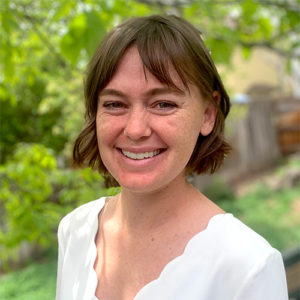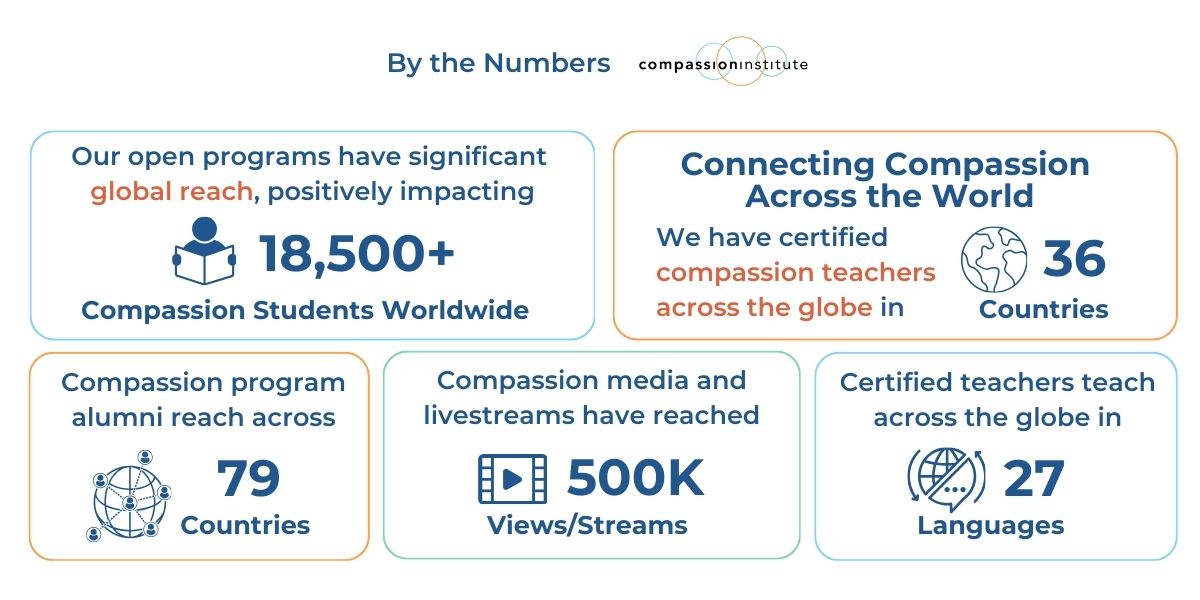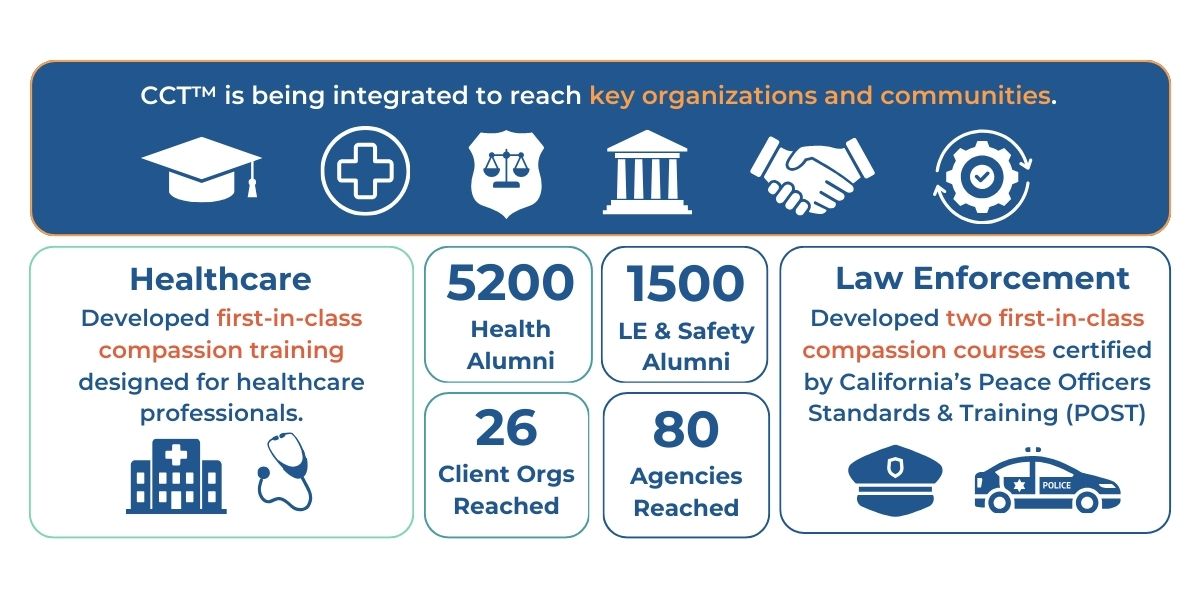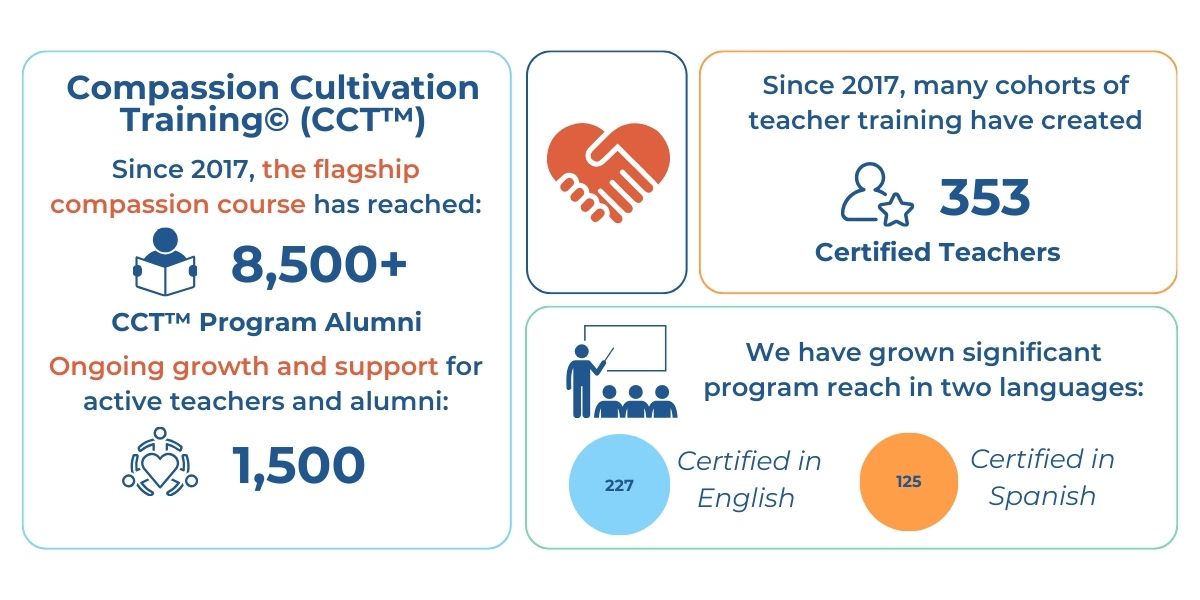2024 Year in Reivew
Fostering a more caring world with transformative evidence-based global compassion programs. You can make an impact today.
Read about how compassion is a universal principle and has improved the lives of people from across the world and in many sectors. Real change, real lives.
One thing that most of us can agree upon is the fact that we all want to be free of suffering and to be happy. But, unfortunately, so many people are experiencing very challenging times that leave them feeling anxious, powerless, and disconnected from one another. If each morning it feels as though you’re bracing for a potentially new crisis, you’re certainly not alone.
We are, in fact, at a critical turning point. We can choose proven practices that foster compassion — for our loved ones, ourselves, and our common humanity — OR we can turn away from this essential strategy for survival.
In recent decades, psychologists and neuroscientists have confirmed compassion is an innate human quality as well as a skill that can be strengthened to help manage suffering and increase well-being for individuals, communities, and society. And you don’t have to live like a monk to experience it for yourself.
Below we’re sharing excerpts from five impactful personal stories we hope can provide you with beneficial insights on how cultivating compassion—and extending it to others—can literally change lives.
Oftentimes, you may find you need only one “go-to tool” from your “compassion toolkit” to help you navigate even the most painful of situations. Take for instance Tori Higa-Sarris’ very personal experience sitting at the bedside of her ailing grandmother, “Peggy,” unsure of how to best cope with their intertwined suffering.

How a Compassion Practice Is Helping Me With Grief
“I inhaled, taking in her pain and darkness, transforming it into something warmer. I exhaled, sending her that warmth and relief. I inhaled her unease, giving it space and turning it into light, and exhaled, sending the ease her way. I repeated this practice all night.” – Tori Sarris, Director, Public Programs
How do you provide comfort to someone who may be dying? How do you bring them peace when they are disoriented, struggling to breathe, and seeking relief? What do you do as you sit by their bedside, holding their hand, but unable to do anything more for them?
I recently experienced firsthand how vital the “active compassion” practice that I first learned about in Compassion Cultivation Training (CCT™) can be. I discovered the effect that this exercise — based on the Buddhist tradition of “Tonglen” — can have on others, as well as how the simple act of breathing can have a huge impact.
Margaret “Peggy” Irene Cole Hall Stickler is my grandmother, and she’s 98 ½ years old. I think it’s important to add the “½ a year” when you get to a certain age — to honor how many days, breaths, and memories you have held. At this impressive age, my grandma has had many beautiful moments, many deeply satisfying breaths, and she holds many joyous memories.
However, a short time ago, her health took a turn — as it will for all of us at some point — and it brought me back to my home state to be by her side and provide her with comfort.
During a recent fitful night, where she could not find rest or understand where she was, I struggled to provide her the same company and support she has given me for so many years. After she called out my name in her sleep — with my heart breaking for her discomfort and request for support — I finally realized how we would get through the night together.
I closed my eyes, took a few cleansing breaths, and focused my mind on my grandmother. On my next inhale, I imagined breathing in her discomfort. As I exhaled, I imagined washing a comforting light over her body. I inhaled, taking in her pain and darkness, transforming it into something warmer. I exhaled, sending her that warmth and relief. I inhaled her unease, giving it space and turning it into light, and exhaled, sending the ease her way. I repeated this practice all night. Breathing in her struggles, transforming them into calm, and breathing out to give her support.
The night was long and she didn’t get much sleep. But this breathwork got us through the darkness of that night … until the sun joined us on the horizon.
Spreading Compassion Around the World


Science-backed compassion training programs — like those we offer at Compassion Institute — have been shown to decrease anxiety, anger, and even reports of chronic pain severity. And when you choose compassion, it can result in an increased sense of purpose, more resilience, and greater ease.
In Tori’s role as Program Director for Compassion Institute’s (CI’s) Public Programs she works tirelessly with our team to address the urgent need for our compassion education programs for the public, to train and certify new CCT™ teachers globally, and spark compassion around the world.
Next, you’ll discover excerpts from a powerful new story that demonstrates how a spark of compassion inspired a woman facing turbulent times to recently become the first certified CCT™ Teacher in the small country of Azerbaijan — where she works for the Institute of Education. And you’ll discover the profound practice that has become one of the most powerful tools she uses when experiencing suffering and isolation.

From Shattered Plans to a Compassionate Life: My Journey as a CCT™ Teacher in Azerbaijan
“Compassion was like sunlight breaking through the clouds of my major depression—softening the harsh, self-critical voice that had been with me for years…compassion has taught me to listen for the need behind those judgments.” – Sevinj Aliyeva
My journey into compassion began amidst a period of turmoil and emotional upheaval.
Originally from Azerbaijan, I was living in Türkiye in 2019, diligently pursuing my studies and preparing to embark on a Ph.D. program in the USA. With my Graduate Record Examination and Test of English as a Foreign Language scores in hand, my application essays completed, and a clear vision for my academic future, everything seemed to be perfectly aligned.
Then, life took an unexpected turn. One phone call changed everything; my mother was diagnosed with breast cancer. My carefully laid plans unraveled in an instant. I packed my bags, prepared to return to Azerbaijan, and grappled with overwhelming emotions — fear, disappointment, and uncertainty about the future. Before leaving Türkiye, my sister-in-law mentioned a seminar happening in Istanbul. Though I was consumed by grief, I decided to attend. I walked into the seminar crying, carrying the weight of my shattered plans.
What happened next changed my life. The moderator held space for my emotions with such compassion and presence that I felt truly seen for the first time. I remember writing in my diary afterward: “Nothing has changed. My Ph.D. plans are still canceled, and my family is still navigating a crisis. But why do I feel so light and calm?” That was my first true encounter with compassion.
Becoming the First Certified CCT™ Teacher in Azerbaijan
Upon returning to my home country, I signed up for an online Compassion Cultivation Training© (CCT™) course, and it marked the beginning of a journey that has shaped my life and work in profound ways. Compassion was like sunlight breaking through the clouds of my major depression — softening the harsh, self-critical voice that had been with me for years. While that voice hasn’t disappeared entirely, compassion has taught me to listen for the need behind those judgments.
One compassion practice that has been transformative for me is visualizing someone, perhaps in Japan or Canada or Australia, experiencing the same struggle. This connection to our shared humanity dissolves the sense of isolation and fosters a deep sense of empathy — for others and for myself.
Seeing the transformative power of compassion in my own life inspired me to teach compassion to others. I felt deeply privileged when I was accepted into the 2023 cohort of the Compassion Institute’s CCT™ Teacher Training program, offered online. This accessibility made it possible for me to take the next step in sharing compassion with my community and beyond.
Cultural Context of Compassion in Azerbaijan
Compassion is often misunderstood in Azerbaijan, a small nation bordered by Russia, Georgia, Armenia and Iran. Many equate it with weakness, naivety, or being overly emotional. This perception, I believe, stems from the Soviet era, when my parents’ generation had little time to process emotions or practice self-compassion. Their parenting style often emphasized “work hard, earn money, and achieve social status” — leaving little room for emotional awareness.
As a CCT™ teacher, I’ve had to address these cultural misconceptions head-on. I frequently create social media content that challenges these stereotypes, offering examples of compassion as a source of strength, resilience, and courage. I share stories from work, family, and daily life to help participants see that compassion is not foreign to our culture — it’s deeply human.
Sharing Compassion With Those Who Serve Us

Above, Sevinj shared her desire to work in organizations where compassion is not just a practice but a guiding principle. Through key partnerships with Compassion Institute, organizations receiving our evidence-based compassion training programs have demonstrated that compassion is a catalyst for both individual and organizational well-being.

Discover the unique perspective of Police Lieutenant Travis Higgins — now a Certified Courageous Heart (CH) Instructor — on how mindfulness and compassion can support wellness for law enforcement personnel.
You’ll find his story is relatable to anyone facing work stress, burnout, or sleep deprivation. It’s also an important reminder for anyone who falsely believes they don’t have the time or resources to prioritize their own well-being.
Additionally, you’ll see how the benefits of the training can go beyond the participants — it can ripple out and exponentially impact the lives of those the organizations serve.

A Police Lieutenant Shares His Unique Perspective on Mindfulness & Compassion
“We started talking about mindfulness and began to be trained in several practices. I saw a major change in my ability to handle stress, the way I thought about stress, and the way I handled sleep.” – Lt. Travis Higgins
I would say the course probably came at a good time in my life. I had been in the law enforcement profession for 18 years and I was very stressed — working busy night shifts, working overtime, and suffering from serious sleep deprivation.
I responded to an email invitation to attend a Courageous Heart 3-Day Immersion. I knew nothing really about yoga, meditation, mindfulness, or compassion.
When I got to the class, I’m not joking when I say within about 20 minutes, I was hooked. And I’m not a person that’s typically drawn in like that. But the workshop just spoke to some of the things I was going through. And at that point, I didn’t even realize that I couldn’t articulate what I was going through exactly. But I was dealing with sleepless nights and chronic stress.
I couldn’t sleep during my work week because I was getting home at 6:00am. I had a young daughter, and I was trying to get her ready to go to daycare because my wife was working at the time. And then I was getting to bed at about 8:00am and found myself wide awake again at 11:00am! I had insomnia, and no idea why…. The impact of that [the lack of sleep] was felt in both my professional and personal life.
On the very first morning of that training we talked about sleep. So that was one of the main hooks for me… We started talking about mindfulness and began to be trained in several practices. I saw a major change in my ability to handle stress, the way I thought about stress, and the way I handled sleep. And then some of the other things that were going on with me, physiologically, began to improve.
I just found a huge benefit to practicing mindfulness. It just really made me so much calmer and happier, and I was really able to connect negative feelings that I was going through with their causes. I learned that if I knew the cause, I could deal with those things.
Awareness & Self-Regulation
Coming out of the immersion, I really focused on a specific meditation, and tried to do it as much as I could. Even though I wasn’t doing a daily practice per se, I was doing it when I could — especially when I would get in stressful situations. I did find that equanimity between a situation and my response to the situation, which I wasn’t able to do very well prior to Courageous Heart training.
Previously, I wasn’t able to be aware and self-regulate as well. I was just basically masking my feelings. I didn’t pay attention to my thoughts and emotions, I ignored them. I had to get through my work week, and then I hoped I could try to relax or reset on my weekends by doing the things that I love to do.
A Turning Point
I was particularly impacted by stress from late 2020 to the beginning of 2021. And I had really wanted to leave law enforcement. However, I was a sergeant at the time and didn’t want to leave the people I worked with. But I lost my passion for law enforcement. I really wanted to find something else. I didn’t like the effect that it had on my life.
I went through some other leadership classes and got back into the mindfulness and compassion sphere in 2021. I started to develop that part of who I was going to be. I also was promoted during that period, so my perspective totally changed. It was perfect timing [when Courageous Heart’s Program Director reached out to me] because I was working on some ways to bring mindfulness and compassion to my agency. And I just remembered how impactful this course was to me.
I’ve been a Courageous Heart facilitator for two years now. And I could talk for 60 minutes on how great the facilitation program was. I really enjoy supporting the participants as they go through their own journey with this work — learning skills and tools that can really help them in their profession as well as in their personal life.
Backed by Research

Research shows what Lieutenant Travis Higgins discovered above — mindfulness and compassion trainings can:
- Reduce the symptoms of stress & burnout
- Increase resilience, self-care, & self-compassion skills
- Increase self-awareness & emotion regulation skills
- Improve health & wellness outcomes
Through scientifically-backed compassion trainings, thousands of participants have discovered tools and skills to actively engage compassion in the moment. You’ll find this positively impacts individuals and organizations who are most in need.
During this time of wide-spread health care staff shortages, we must give the tools of compassion and wellbeing to those who serve our fellow humans already experiencing vast health care disparities — including those in impoverished and underserved communities.
Findings from research on healthcare workers reveal how compassion training can help prevent burnout, and positively impact patient health outcomes. Read about Infectious Disease doctor Sudha Nagalingam, M.D. ‘s personal experience with it.

A Doctor’s Journey Into Self & Collective Care
“I am now able to reframe major stressors and look at them through a different, more objective lens to assist in managing them in real time.” – Dr. Sudha Nagalingham
“I consider my caregiving role a privilege,” says Infectious Disease doctor Sudha Nagalingam, M.D. “I’m invited into a patient’s life to help them at what is probably the lowest point in their health journey,” she adds.
Dr. Nagalingam is the Medical Director for El Rio Special Immunology Associates and the HIV Ryan White Clinic which are part of El Rio Health (El Rio) — an innovative nonprofit dedicated to improving the health of the Tucson, Arizona community through comprehensive, accessible, affordable, quality, and compassionate care.
In early 2022, El Rio’s Chief Clinical Officer, Douglas Spegman, MD, and several providers from El Rio—including Nagalingam—took the opportunity to participate in the Compassion Institute (CI) course, Caring From the Inside Out: Foundations of Self and Collective Care (CFIO).
Dr. Nagalingam recalls that senior staff encouraged providers to participate in this live, online course. “They whole-heartedly embraced provider wellness and changed our work environment into a culture of wellness. We were just coming out of two years of the pandemic, and I did not realize how much of a toll it had taken on me both physically and emotionally, so this program sparked an interest.”
Of her experience with the program, Dr. Nagalingam also says, “CFIO highlighted that personal wellness did not have to be a weeklong retreat to an expensive spa or an extensive vacation, but small steps that could be done daily to allow for rest and rejuvenation, quiet time to reflect and reset myself.”
Through her journey she identified that physical exercise and personal quiet time are essential elements to her wellness, adding, “I embarked on a pathway of lifestyle medicine… including better sleep, healthier eating, regular activity, instead of being glued to my computer, completing charts until the night.”
As a result of the tools she gained in the program, Nagalingam shares, “I am now able to reframe major stressors and look at them through a different, more objective lens to assist in managing them in real time.”
Creating Compassionate Cultures

Dr. Nagalingam’s experience with compassion is not an exception. Impressive, peer-reviewed research has demonstrated both that compassion is teachable and that such trainings are beneficial for physical and mental health.

And in the following story excerpts by Miroo Kim, you’ll discover how compassion trainings benefited her in the face of burnout and how it led her to become a certified CCT teacher. You’ll also find what she discovered at the bottom of her own suffering as well as the moving responses she witnessed when teaching CCT to fellow employees at the largest social media platform in the world.

From Corporate Burn-Out To Compassionate Living
“This embodiment of mindful and compassionate presence also created a very meaningful impact on me as a leader at work….I was promoted twice in two years!…Yet the best part was something else, which I found most surprising: I was able to perform without getting stressed out.” – Miroo Kim, Corporate Alumni & CCT™ Teacher
On the surface my life was going “as planned,” and yet I felt hollow inside.
In 2017, I had an amazing career, having progressed from various roles at Apple and Microsoft to a partnership team at Facebook (now Meta Platforms). I was progressing as a leader and working with various partners globally on many high impact projects. I was feeling safe financially and able to provide for my family back in Korea, too.
Additionally, I traveled around the world for fun and for work, meeting many interesting people. Everything looked good, right?
Except I felt very empty.
The work culture in the tech industry was always highly competitive and fast-paced, regardless of which company I worked at. I was able to build great professional skill sets from being in these types of environments for 13 years, but I was also suffering immensely internally.
My main coping mechanism in difficult situations has always been “learning.” So I started taking many courses in 2017, and one of the trainings that stood out to me was the Compassion Cultivation™ Training (“CCT™”) — initially developed at Stanford University by Thupten Jinpa, Ph.D. with contributions from Compassion Institute’s Founding Faculty.
Learning to Be With My Own Suffering
I discovered so much in the CCT™ class, but the most transformative learning moment was when I felt what it meant to be with my own suffering instead of trying to fix it.
Sitting with my painful experiences from the past, I could feel everything that came with it — the details of the experience, the emotions, and the thoughts behind the emotions. At first it was so challenging, but eventually all of the swirling, difficult emotions started to settle on the ground, like in a snow globe. I could finally see what was at the bottom of my suffering.
There wasn’t much, which was both surprising and anticlimactic. It was just my own idea about myself and my expectations on how things should be. When I asked myself the question, “Is there any truth behind these ideas and expectations?,” they evaporated. No, they were just stories created in my mind, not truth.
Taking the Leap into CCT™ Teacher Training
As I finished the CCT™ program, I started thinking about what I could do with my training. Obviously, I would continue to practice compassion personally, but I was eager to share it with more people at my workplace in the tech industry — where the word compassion sounds like a foreign language. This aspiration led me to apply for the CCT™ Teacher Training with the Compassion Institute (CI) in 2018. With great teachers and fellow trainees, I went through an 11-months training journey, including teaching a practicum class at Facebook, my workplace.
Embodiment of Mindful & Compassionate Presence
In my own CCT™ program, I learned how important this was in creating a safe space for participants; as I was able to embody a gentle attitude toward myself, participants in the class were able to learn how to be gentle with themselves.
This embodiment of mindful and compassionate presence also created a very meaningful impact on me as a leader at work. I started paying more attention to how I listened to others in all forms of communication …. I started getting better feedback from my managers and my team. And it showed in my performance evaluation — I was promoted twice in two years! … Yet the best part was something else, which I found most surprising: I was able to perform without getting stressed out.
A Community of Compassionate Relationship at Workplaces
As I got certified by the Compassion Institute to teach CCT™ in 2019, I started offering the classes for the Mindfulness Club members at Facebook.
At first, I thought I could help the colleagues most by correcting their misunderstandings about compassion. But what I discovered as I led more CCT™ classes was students were less interested in intellectual learning than in the sense of comfort they experienced by learning how to relate to each other compassionately.
As I finished teaching the eighth week of CCT™ with one cohort, a tearful participant said that she never expected that she could be herself at work — sharing her own struggle juggling many roles in her life as a mother, wife, daughter, manager, and employee. Others echoed that they were feeling sad to think that it was the last class. Some were suggesting to continue to meet even after the class was over.
This response wasn’t limited to one cohort but repeated over and over. Every time I saw such responses, my heart ached because I could feel the suffering of so many people at workplaces who desperately want to be seen and heard as a whole being — not just as an employee. At the same time, I felt hopeful because I was learning that it was possible to create a space to help people see each other as whole beings. It was possible to create a community of compassionate relationships at workplaces.

Your Choice Can Make the Difference
Your support can create a meaningful, long-term difference in someone’s life.
As mentioned above, we’re at a critical turning point. If we’re not attending to suffering, we’re neglecting an essential survival strategy. We can choose to turn on ourselves and each other or join a mass movement that is elevating compassion and well-being as a non-negotiable priority.
As demonstrated by the deeply personal stories above, we each have the potential to relieve suffering and spread well-being. It may be as simple as choosing one compassionate action or practice. Once you’re connected to the kinder parts of yourself through self-compassion, you’ll be more resourced to gradually extend compassion outwards — and possibly even heal divides with the people you find most challenging.
It could also look like extending your advocacy and support so that compassion becomes THE foundation for our personal lives, organizations, companies, and societies. So it becomes the core value of humanity that’s always prioritized — especially when time and resources feel scarce.
The reality of the world right now calls for each one of us to connect with our shared humanity. We urgently need to discover how to view and engage with ourselves, others, and the world from a place of empathy and compassion.
Fortunately compassion is a strength and renewable energy source that can help each of us to move forward and create positive changes with more purpose and joy.
Will you choose compassion today?
Donate Today
Compassion is a bridge. Your gift today can be the bridge between someone’s suffering and their well-being.
Compassion Institute is a 501(c)3. You can donate to help us advance compassion as a guiding principle and active force to foster a more caring world.
Your gift will help Compassion Institute deliver research-backed compassion practices and courses to the individuals and organizations who are most in need:
- ⦿ $50 will help fund free guided compassion practice videos so people facing suffering, like Tori, have tools to give and receive loving kindness.
- ⦿ $100 can help provide a scholarship to an individual facing financial hardship to gain lifelong skills in our Compassion Cultivation Training (CCT) program.
- ⦿ $250 can help spread compassion practices and courses globally via CCT Teacher Training sessions & organizations who serve marginalized communities.
Donate to the right to help us reach our $5K goal.

Yes, Compassion Institute is a 501(c)3 non-profit organization and your donation may be tax deductible. We encourage you to consult your tax professional regarding this.
Thank you for your contributions towards creating a more caring, compassionate world!

